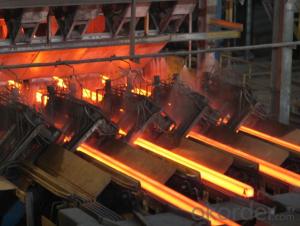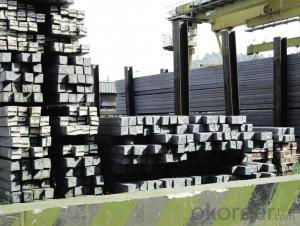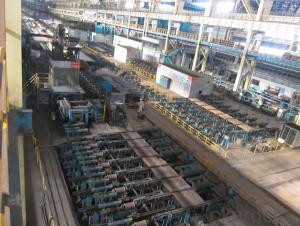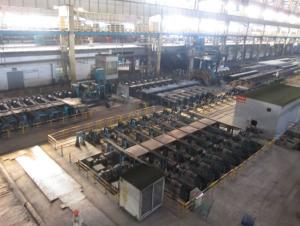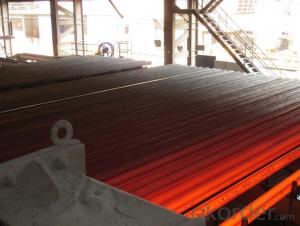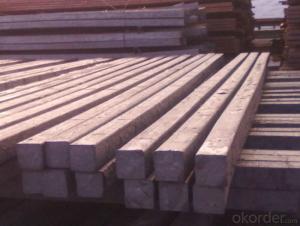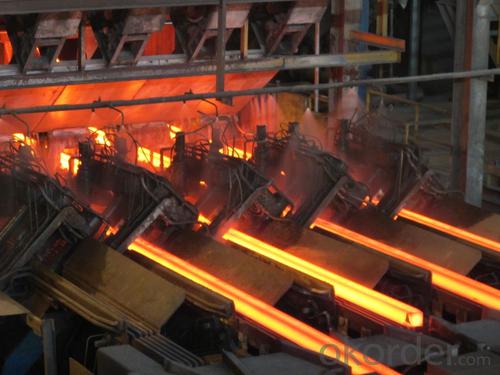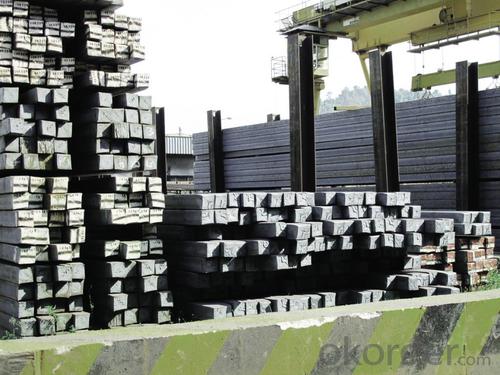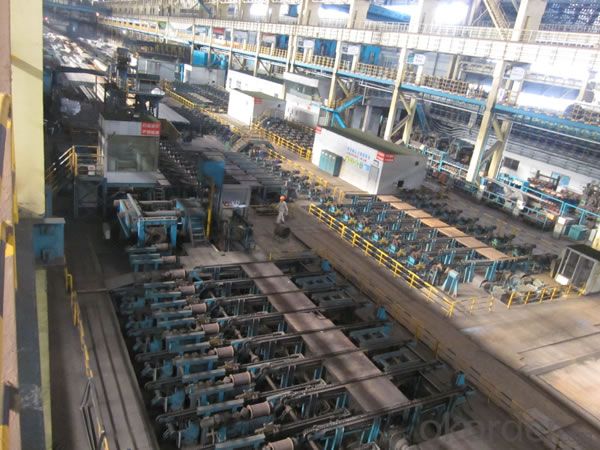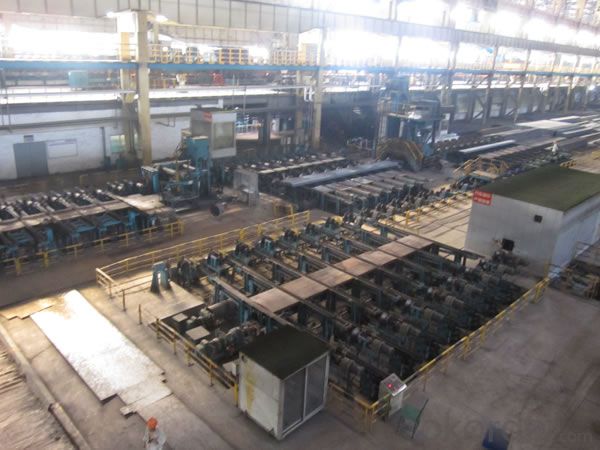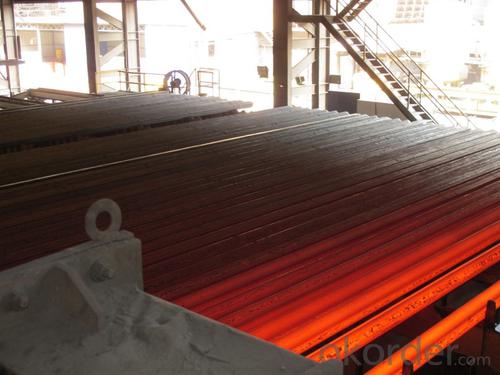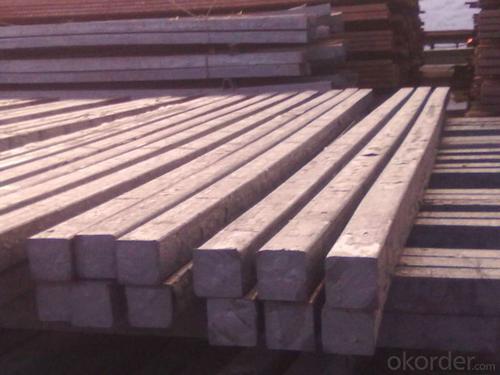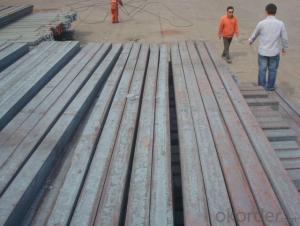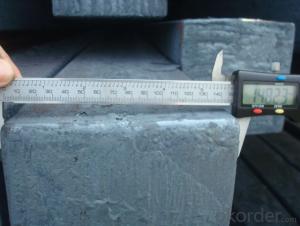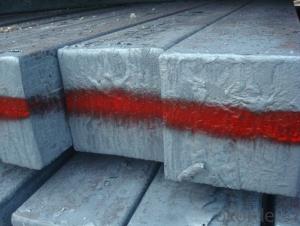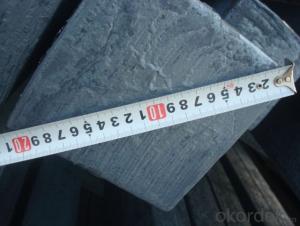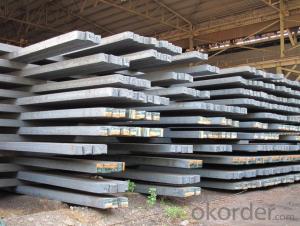Hot Rolled Steel Billet 3SP Standard 125mm
- Loading Port:
- Shanghai
- Payment Terms:
- TT OR LC
- Min Order Qty:
- 100 m.t.
- Supply Capability:
- 10000 m.t./month
OKorder Service Pledge
OKorder Financial Service
You Might Also Like
Structure of Hot Rolled Steel Billet 3SP Standard 125mm
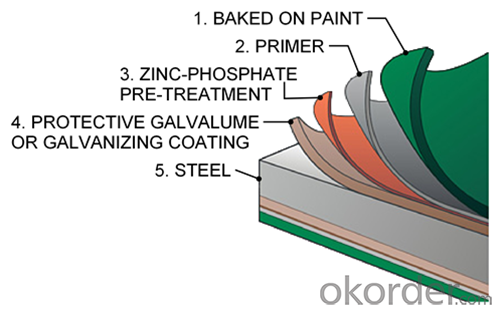
Description of Hot Rolled Steel Billet 3SP Standard 125mm
Prepainted Rolled steel Coil is a kind of coated steel coil/sheet. With the cold rolled steel of different strength and thickness as substrate, it is produced through applying Al-Zn coat on both faces by hot dip process. In its coating, Al accounts for about 55%, Si 1.6%, while the remaining is Zn. Aluminum zinc coils enjoys both the physical protective feature and durability of Al and the electrochemical protective property of Zn. And its surface has bright silver color and regular embossed-like figure, which are highly decorative. RAL Scale Z35 Prepainted Rolled Steel Coil for Construction Roofing
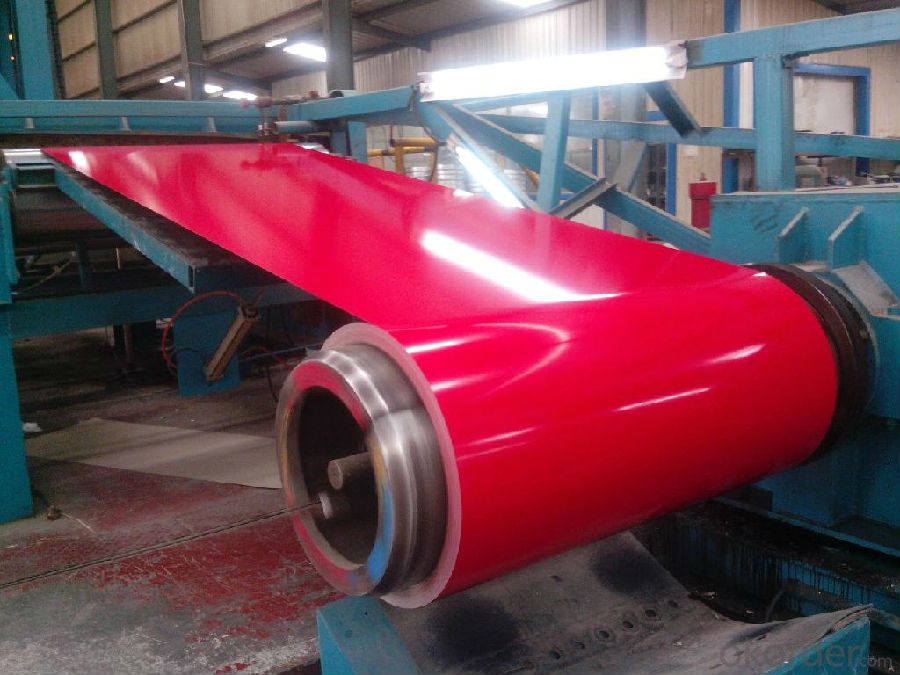
Main Feature of Hot Rolled Steel Billet 3SP Standard 125mm
1.Corrosion resistance: It mainly depends on the zinc protection. When the zinc being worn,
2. Heat resistance: steel sheet has excellent heat resistance, can withstand high temperatures over 300 centigrade, and is similar with aluminized steel high temperature oxidation resistance. It often used in chimney pipes, ovens, fluorescent lighting device and the device cover.
3. Heat reflective: Galvanized steel plate heat-reflective high rate is twice as galvanized steel, often used to make insulation materials. RAL Scale Z35 Prepainted Rolled Steel Coil for Construction Roofing
Applications of Hot Rolled Steel Billet 3SP Standard 125mm
1. Construction and building: roofing; ventilating duct; handrail; partition panel;etc.
2. Electric appliance: refrigerator; washing machine; refrigerator; DVD;etc.
3.Transportation: oil tank; gas tank;road sign; etc.
4.Agriculture constructions :barn; etc.RAL Scale Z35 Prepainted Rolled Steel Coil for Construction Roofing
5.Others:vending machine; game machine; auto parts spare parts etc.
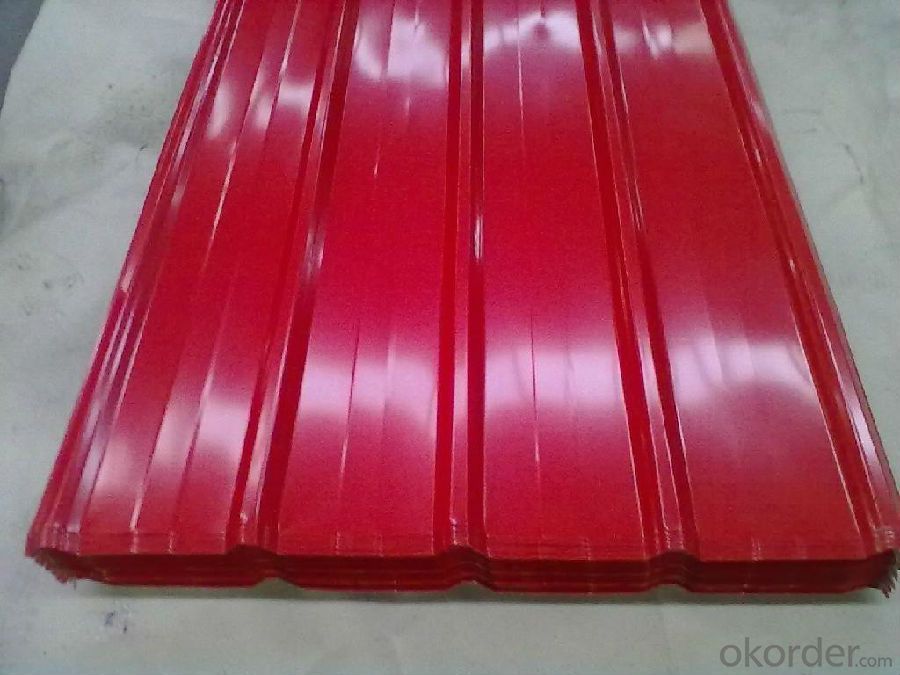
Specifications of Hot Rolled Steel Billet 3SP Standard 125mm
Product | Hot Rolled Steel Billet 3SP Standard 125mm |
Material Grade | SGCC / SGCH / DX51D+AZ, etc |
Thickness | 0.5-3.0mm |
Width | 700-1500mm |
Tolerance | Thickness: +/-0.02mm , Width:+/-2mm |
Zinc-coating | AZ30-150g/m2 |
Technique | Raw material: Hot rolled steel coil --> Cold rolled_>hot dipped galvalume |
Surface | Dried, Chromated, Unoiled,RAL Scale Z35 Prepainted Rolled Steel Coil for Construction Roofing |
Spangle | Regular spangle , small spangle, zero spangle |
ID | 508MM 610MM |
Coil weight | 25MT max |
Export package | Cardboard inner sleeves, Waterproof paper, galvanized steel covered and steel strip packed |
FAQ of Hot Rolled Steel Billet 3SP Standard 125mm
We have organized several common questions for our clients,may help you sincerely:
1. What is the minimum order quantity ?
Our MOQ is 100 mt for each size each specification. Usually we can offer discount if can buy large QTY once. RAL Scale Z35 Prepainted Rolled Steel Coil for Construction Roofing
2. How long can we receive the product after ordering?
Our general delivery time is 30 days after confirmation, but so some special orders, we have offer special delivery time
3. How to guarantee the quality of the products?
We have established the international advanced quality management system ,every link from raw material to final product we have strict quality test;We resolutely put an end to unqualified products flowing into the market. At the same time, we will provide necessary follow-up service assurance.
4. What is the payment?
We accept T/T, L/C
- Q: What are the different surface treatment options for steel billets?
- Some of the different surface treatment options for steel billets include pickling, shot blasting, galvanizing, painting, and powder coating.
- Q: What are the different testing methods used for steel billets?
- To ensure the quality and suitability of steel billets for various applications, multiple testing methods are employed. These methods encompass: 1. Visual Inspection: The most straightforward and widely used technique involves visually examining the billets for visible defects like cracks, surface irregularities, or foreign materials. 2. Dimensional Inspection: To meet specific dimensional requirements, the length, width, and height of the billets are measured using calibrated tools, ensuring they adhere to the specified tolerances. 3. Ultrasonic Testing: Detecting internal defects, this non-destructive method employs high-frequency sound waves. By transmitting sound waves into the material and analyzing the reflected waves, flaws or inconsistencies can be identified. 4. Magnetic Particle Inspection: Utilized primarily to detect surface and near-surface defects, this method applies a magnetic field to the billet, followed by the application of a magnetic particle solution. Any cracks or defects cause the particles to accumulate, creating visible indications. 5. Eddy Current Testing: This technique involves passing an alternating current through a probe, generating an electromagnetic field. Placing the probe near the billet's surface allows the detection of defects through changes in electrical conductivity or magnetic permeability, which induce eddy currents. 6. Chemical Analysis: The composition of steel billets, including the percentage of elements like carbon, manganese, and silicon, is determined through chemical analysis. This ensures compliance with the required chemical composition for their intended use. 7. Tensile Testing: By subjecting a sample taken from the billet to tension until it fractures, tensile testing measures mechanical properties such as strength, ductility, and elasticity. The applied force and resulting elongation or deformation provide insights into the billet's mechanical characteristics. These testing methods comprehensively assess steel billets for defects, dimensional accuracy, and material properties. By ensuring adherence to industry standards and meeting specific application requirements, the suitability and quality of the billets are guaranteed.
- Q: What are the different grades of steel used for making billets?
- There are several different grades of steel that are commonly used for making billets. The specific grade of steel used depends on the intended application and the desired properties of the billet. One commonly used grade of steel for making billets is carbon steel. Carbon steel is a versatile and relatively inexpensive option that offers good strength and hardness. It is often used in applications where high strength is required, such as in the construction industry. Another grade of steel commonly used for billet production is alloy steel. Alloy steel is made by adding various alloying elements to carbon steel, such as chromium, nickel, or molybdenum. This results in improved strength, toughness, and corrosion resistance, making alloy steel suitable for a wide range of applications including automotive parts, machinery components, and tooling. Stainless steel is another grade of steel that is often used for making billets. Stainless steel contains a minimum of 10.5% chromium, which provides excellent corrosion resistance. It is commonly used in industries requiring resistance to oxidation and corrosion, such as the food and beverage industry, medical equipment manufacturing, and architectural applications. Additionally, there are specialized grades of steel used for specific applications. For example, high-speed steel (HSS) is used for making billets used in cutting tools, as it offers exceptional hardness and heat resistance. Tool steel is another specialized grade used for making billets for tools and dies, offering high hardness, wear resistance, and toughness. In summary, the different grades of steel used for making billets include carbon steel, alloy steel, stainless steel, high-speed steel, and tool steel. The choice of grade depends on the specific requirements of the application, such as strength, toughness, corrosion resistance, or specialized properties needed for cutting tools or tooling.
- Q: How do steel billets contribute to the manufacturing of automotive components?
- Steel billets play a crucial role in the manufacturing of automotive components. These billets, which are semi-finished metal pieces, serve as the starting material for the production of various automotive parts. One of the main ways steel billets contribute to automotive component manufacturing is through the process of forging. Forging involves shaping the metal billets under high pressure and temperature, typically using a hammer or a press, to create the desired automotive parts. This process helps in enhancing the strength, durability, and reliability of the components, making them suitable for the demanding conditions of the automotive industry. Steel billets are also used in the production of engine components such as crankshafts, connecting rods, and piston rods. These parts require high strength and resistance to wear and tear, which are achieved by starting with high-quality steel billets. By using steel billets as the raw material, automotive manufacturers can ensure that the resulting components have the necessary mechanical properties to withstand the stresses and forces experienced by the engine during operation. Furthermore, steel billets are employed in the manufacturing of suspension components, such as control arms and stabilizer bars. These components are responsible for maintaining the stability, handling, and comfort of the vehicle. Using steel billets in their production ensures that the suspension components can withstand the heavy loads and impacts encountered on the road, providing a smooth and safe driving experience. Additionally, steel billets contribute to the manufacturing of safety-related automotive components. For instance, they are used in the production of structural components like chassis frames and body reinforcements. These components are essential for protecting the occupants in the event of a collision or impact, and steel billets provide the necessary strength and rigidity to ensure their effectiveness. In conclusion, steel billets are a vital element in the manufacturing of automotive components. They enable the production of strong, durable, and reliable parts, ensuring the overall performance, safety, and longevity of vehicles. By starting with high-quality steel billets, automotive manufacturers can meet the demanding requirements of the industry and deliver high-performance vehicles to consumers.
- Q: How are steel billets used in the production of seamless tubes?
- Seamless tubes production heavily relies on steel billets as a crucial raw material. At the initial stage of the manufacturing process, these billets are utilized for the formation of seamless tubes through hot rolling or extrusion. Initially, steel billets undergo high-temperature heating to enhance their malleability. This heating process, known as hot rolling, facilitates easy shaping and manipulation of the billets. Following this, the heated billets are passed through a series of rollers or extrusion dies, transforming them into a cylindrical shape, which serves as the fundamental structure of a seamless tube. The rolling or extrusion process subjects the steel billets to significant deformation. The pressure exerted by the rollers or dies induces the flow of metal and fills the cavities, resulting in the creation of seamless tubes. The dimensions and specifications of the final seamless tube are determined by the size and shape of the billets. In addition, steel billets contribute significantly to the mechanical properties of the seamless tubes. The quality and composition of the billets play a crucial role in determining the strength, durability, and resistance to corrosion of the tubes. Proper selection and quality control of the billets are imperative to ensure the production of seamless tubes that meet industry standards and customer requirements. To summarize, steel billets are indispensable in the production of seamless tubes. Through the processes of heating, shaping, and forming via hot rolling or extrusion, steel billets are transformed into seamless tubes with specific dimensions and mechanical properties. These high-quality seamless tubes find extensive applications in industries such as oil and gas, automotive, construction, and manufacturing.
- Q: What are the different surface treatments applied to alloy steel billets?
- Enhancing the properties and performance of alloy steel billets can be achieved through various surface treatments. One commonly used treatment involves bombarding the billet surface with small metal or ceramic particles at high velocity, a process known as shot blasting. This effectively eliminates impurities and contaminants, resulting in a clean and uniform surface finish. Additionally, shot blasting promotes the adhesion of subsequent coatings or treatments. Another method, known as pickling, entails immersing the billets in an acid solution to remove oxides and scale from the surface. This not only improves the surface quality but also eliminates any defects, preparing the billets for further processing or treatments. Heat treatment is a popular surface treatment for alloy steel billets. By subjecting the billets to controlled heating and cooling processes, their microstructure can be altered, leading to improved mechanical properties. This treatment can enhance the hardness, strength, and toughness of the billets, rendering them more suitable for specific applications. Furthermore, alloy steel billets can be coated with protective coatings to enhance corrosion resistance and durability. Common techniques include hot-dip galvanizing, electroplating, and painting. These coatings serve as a barrier between the alloy steel surface and the environment, effectively preventing corrosion and extending the lifespan of the billets. To summarize, shot blasting, pickling, heat treatment, and protective coatings are among the various surface treatments applied to alloy steel billets. These treatments enhance surface quality, improve mechanical properties, and protect against corrosion, ensuring optimal performance in diverse applications.
- Q: What is the weight of a standard steel billet?
- The dimensions and specific alloy composition of a standard steel billet can cause its weight to fluctuate. On average, the weight of a standard steel billet falls between 1,000 and 1,500 kilograms, equivalent to 2,204 and 3,307 pounds. It is worth mentioning that steel billets may have varying standard sizes and weight ranges depending on the industry and region.
- Q: What are the different methods of steel billet surface plating?
- There are several different methods of steel billet surface plating, each with its own advantages and applications. Some of the most common methods include: 1. Electroplating: This is a widely used method where an electric current is used to deposit a layer of metal onto the surface of the steel billet. The billet is submerged in a solution containing metal ions, and when the current is applied, the metal ions are attracted to the steel surface, forming a thin coating. 2. Hot-dip galvanizing: In this method, the steel billet is dipped into a bath of molten zinc. The high temperature causes the zinc to bond with the steel, forming a protective layer. This process is commonly used for steel structures that will be exposed to harsh environments or corrosive elements. 3. Powder coating: This technique involves applying a dry powder to the surface of the steel billet, which is then heated to form a protective layer. Powder coating offers excellent durability, resistance to corrosion, and a wide range of color options. 4. Physical vapor deposition (PVD): PVD is a method where a thin film of metal is deposited onto the surface of the steel billet through a physical process such as evaporation or sputtering. This technique is commonly used for decorative purposes and to enhance the hardness and wear resistance of the steel surface. 5. Chemical conversion coating: This process involves treating the steel billet with a chemical solution that forms a protective layer on the surface. Common conversion coatings include phosphate and chromate coatings, which provide corrosion resistance and improve paint adhesion. 6. Thermal spraying: In this method, a heated material, typically a metal or ceramic powder, is sprayed onto the steel billet surface using a high-velocity gas or flame. The sprayed material forms a coating, providing enhanced protection against wear, corrosion, and high temperatures. Each of these methods has its own benefits and is suitable for different applications. The choice of plating method depends on factors such as the desired level of protection, cost, aesthetics, and specific requirements of the steel billet's end use.
- Q: How are steel billets used in the production of wire rods and bars?
- Steel billets are used in the production of wire rods and bars as they serve as the initial raw material. These billets are heated and then rolled or forged into long, slender shapes to create wire rods or bars. The size and shape of the billets determine the final dimensions of the wire rods or bars, which are used in various industries such as construction, automotive, and manufacturing.
- Q: What are the main factors affecting the thermal expansion of steel billets?
- The main factors affecting the thermal expansion of steel billets include temperature, composition of the steel, and the grain structure of the material.
Send your message to us
Hot Rolled Steel Billet 3SP Standard 125mm
- Loading Port:
- Shanghai
- Payment Terms:
- TT OR LC
- Min Order Qty:
- 100 m.t.
- Supply Capability:
- 10000 m.t./month
OKorder Service Pledge
OKorder Financial Service
Similar products
Hot products
Hot Searches
Related keywords
